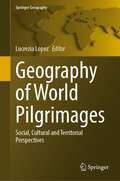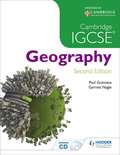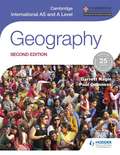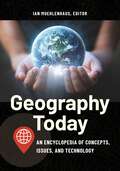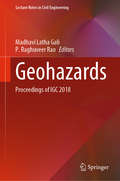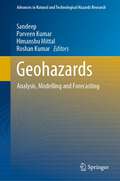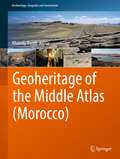- Table View
- List View
The Geography of Underdevelopment: Institutions and the Impact of Culture
by Mariam KhawarThis book examines why the differences in comparative economic development across the world have a geographical pattern. It argues that there is a missing component in the geography versus institutions debate, namely the role of culture and its impact either directly on development or indirectly through the establishment of institutions. The impact of geographical features such as climate and natural resources is studied both across countries and within political boundaries and is supplemented by the work of social scientists in other disciplines on culture and cultural evolution. By examining the direct effects of geography on standards of living as well as its indirect effects via culture and institutions, a case is made to tie all three factors into a cohesive explanation for underdevelopment. This book will appeal to readers interested in wider perspectives on under-development that go beyond explanations resting on standard neo-classical economic theory.
The Geography of Uzbekistan: At the Crossroads of the Silk Road (World Regional Geography Book Series)
by Lola GulyamovaThis book describes the geography of Uzbekistan and its unique history and culture. It focuses on the development of Uzbekistan as a result of its location on the crossroads of the Silk Road. The influence of global and regional environmental challenges on the current landscape and similar issues are discussed and analyzed from a historical perspective. Contemporary tensions and reforms in social, economical and cultural life are described with the aim to draw a picture of modern paths to transformation and development. The Geography of Uzbekistan includes also information on geology, nature and natural resources, in particular water. The book discusses the social and environmental impacts of the Aral Sea disaster and shows new paths of transformation and development for this Central Asian country.
The Geography of Wine: Regions, Terroir and Techniques
by Percy H. DoughertyWine has been described as a window into places, cultures and times. Geographers have studied wine since the time of the early Greeks and Romans, when viticulturalists realized that the same grape grown in different geographic regions produced wine with differing olfactory and taste characteristics. This book, based on research presented to the Wine Specialty Group of the Association of American Geographers, shows just how far the relationship has come since the time of Bacchus and Dionysus.Geographers have technical input into the wine industry, with exciting new research tackling subjects such as the impact of climate change on grape production, to the use of remote sensing and Geographical Information Systems for improving the quality of crops. This book explores the interdisciplinary connections and science behind world viticulture. Chapters cover a wide range of topics from the way in which landforms and soil affect wine production, to the climatic aberration of the Niagara wine industry, to the social and structural challenges in reshaping the South African wine industry after the fall of apartheid. The fundamentals are detailed too, with a comparative analysis of Bordeaux and Burgundy, and chapters on the geography of wine and the meaning of the term ‘terroir’.
Geography of World Pilgrimages: Social, Cultural and Territorial Perspectives (Springer Geography)
by Lucrezia LopezThis book points out how pilgrimage studies rely on interdisciplinary academic interests, being always more determined by anthropological, social, cultural and economic factors. The volume gathers interdisciplinary contributions revealing different approaches and academic interests when researching pilgrimage. Finally, the proposal introduces a comparative international breath to reflect upon such complex phenomenon that since Antiquity still impregnates the history of human being across the world. As pilgrimage studies are closely related to mobility issues, how the contemporary mobile world is altering and re-signifying pilgrimage dynamics and meanings will also be discussed in detail. The term “pilgrimage” evokes key concepts deriving from different fields, all of them collected in the final glossary.The primary audience of this work are academics and researchers from different fields involved in pilgrimage studies. The work may also be useful in teaching (advanced) university courses.
Geography (PDF)
by Paul Guinness Garrett NagleSecond / 2nd edition. Endorsed by Cambridge International Examinations Provide a key resource for your students with this revised edition for the updated 2016 syllabus (0460). This book has been carefully prepared to cover the full curriculum for the latest Cambridge International Examinations IGCSE Geography syllabus. It is accompanied by a CD-ROM offering study and revision support. - Covers the three geographical themes: population and settlement, the natural environment, and economic development - Up-to-date case studies from around the world ensure coverage of all the required case studies - Geographical skills and geographical investigations chapters provide ideal preparation for Papers 2 and 3
Geography (PDF)
by Garrett Nagle Paul GuinnessWe are working with Cambridge International Examinations to gain endorsement for this edition for the revised 2017 syllabus. - Covers the full content of the syllabus - Written by the same renowned author team as the first edition and the bestselling Cambridge IGCSE Geography - Supports the development of geographical skills, which feature more prominently in the latest syllabus
Geography (PDF)
by Sheena WilliamsonExam board: SQA Level: Higher Subject: Geography First teaching: September 2018 First exam: Summer 2019
Geography Today: An Encyclopedia of Concepts, Issues, and Technology
by Ian MuehlenhausGeography Today provides a thoughtful and thorough introduction to the study of geography—from maps and technology to the study of different cultures, political systems, and economies, and an investigation of plate tectonics and climate systems.Geography Today: An Encyclopedia of Concepts, Issues, and Technology approaches the study of geography by concept, in contrast to most other works, which are organized by world region. Geography curriculums have been moving away from teaching the topic on a regional basis and toward teaching it through broader concepts. This is modeled by the National Geography Standards, the National Council for Geographic Education's Roadmap for 21st Century Geography Education, Texas Essential Knowledge and Skills Resource System, and ABC-CLIO's own geography advisory board, comprised of high school geography teachers from across the United States. By introducing geography concepts, Geography Today sets the foundation for readers to understand why certain geographies may be the way they are. It further helps high school geography students to apply concepts to different contexts with 101 geography terms, themes, and concepts for quick-reference research and study.
Geography Today: An Encyclopedia of Concepts, Issues, and Technology
by Ian MuehlenhausGeography Today provides a thoughtful and thorough introduction to the study of geography—from maps and technology to the study of different cultures, political systems, and economies, and an investigation of plate tectonics and climate systems.Geography Today: An Encyclopedia of Concepts, Issues, and Technology approaches the study of geography by concept, in contrast to most other works, which are organized by world region. Geography curriculums have been moving away from teaching the topic on a regional basis and toward teaching it through broader concepts. This is modeled by the National Geography Standards, the National Council for Geographic Education's Roadmap for 21st Century Geography Education, Texas Essential Knowledge and Skills Resource System, and ABC-CLIO's own geography advisory board, comprised of high school geography teachers from across the United States. By introducing geography concepts, Geography Today sets the foundation for readers to understand why certain geographies may be the way they are. It further helps high school geography students to apply concepts to different contexts with 101 geography terms, themes, and concepts for quick-reference research and study.
Geography Unbound: French Geographic Science from Cassini to Humboldt
by Anne Marie GodlewskaAt the end of the eighteenth century, French geographers faced a crisis. Though they had previously been ranked among the most highly regarded scientists in Europe, they suddenly found themselves directionless and disrespected because they were unable to adapt their descriptive focus easily to the new emphasis on theory and explanation sweeping through other disciplines. Anne Godlewska examines this crisis, the often conservative reactions of geographers to it, and the work of researchers at the margins of the field who helped chart its future course. She tells her story partly through the lives and careers of individuals, from the deposed cabinet geographer Cassini IV to Volney, von Humboldt, and Letronne (innovators in human, physical, and historical geography), and partly through the institutions with which they were associated such as the Encyclopédie and the Jesuit and military colleges. Geography Unbound presents an insightful portrait of a crucial period in the development of modern geography, whose unstable disciplinary status is still very much an issue today.
Geography Unbound: French Geographic Science from Cassini to Humboldt (Chicago History Of American Civilization Ser.)
by Anne Marie GodlewskaAt the end of the eighteenth century, French geographers faced a crisis. Though they had previously been ranked among the most highly regarded scientists in Europe, they suddenly found themselves directionless and disrespected because they were unable to adapt their descriptive focus easily to the new emphasis on theory and explanation sweeping through other disciplines. Anne Godlewska examines this crisis, the often conservative reactions of geographers to it, and the work of researchers at the margins of the field who helped chart its future course. She tells her story partly through the lives and careers of individuals, from the deposed cabinet geographer Cassini IV to Volney, von Humboldt, and Letronne (innovators in human, physical, and historical geography), and partly through the institutions with which they were associated such as the Encyclopédie and the Jesuit and military colleges. Geography Unbound presents an insightful portrait of a crucial period in the development of modern geography, whose unstable disciplinary status is still very much an issue today.
Geography Unbound: French Geographic Science from Cassini to Humboldt
by Anne Marie GodlewskaAt the end of the eighteenth century, French geographers faced a crisis. Though they had previously been ranked among the most highly regarded scientists in Europe, they suddenly found themselves directionless and disrespected because they were unable to adapt their descriptive focus easily to the new emphasis on theory and explanation sweeping through other disciplines. Anne Godlewska examines this crisis, the often conservative reactions of geographers to it, and the work of researchers at the margins of the field who helped chart its future course. She tells her story partly through the lives and careers of individuals, from the deposed cabinet geographer Cassini IV to Volney, von Humboldt, and Letronne (innovators in human, physical, and historical geography), and partly through the institutions with which they were associated such as the Encyclopédie and the Jesuit and military colleges. Geography Unbound presents an insightful portrait of a crucial period in the development of modern geography, whose unstable disciplinary status is still very much an issue today.
Geohazard-associated Geounits: Atlas and Glossary (Environmental Science and Engineering)
by L. A. RivardOriginally conceived as a technical manual, but now offering the reader so much more, this timely work deals with various aspects of geohazards – surely an area of growing importance in this world of global warming. Using photogeology and remote sensing, Quebecois researcher Rivard’s work is unique in that the succinct text supports the illustrations, and is devised as a quick-reference, standardized presentation of 170 globally occurring photo-geomorphological units.
Geohazard Mitigation: Select Proceedings of VCDRR 2021 (Lecture Notes in Civil Engineering #192)
by Basanta Raj Adhikari Sreevalsa KolathayarThis book presents the select proceedings of the Virtual Conference on Disaster Risk Reduction (VCDRR 2021). It emphasizes on the role of civil engineering for a disaster resilient society. It presents latest research in geohazards and their mitigation. Various topics covered in this book are land use, ground response, liquefaction, and disaster mitigation techniques. This book is a comprehensive volume on disaster risk reduction (DRR) and its management for a sustainable built environment. This book will be useful for the students, researchers, policy makers and professionals working in the area of civil engineering, especially disaster management.
Geohazards: Proceedings of IGC 2018 (Lecture Notes in Civil Engineering #86)
by Madhavi Latha Gali P. Raghuveer RaoThis volume comprises select papers presented during the Indian Geotechnical Conference 2018. This volume discusses concepts of soil dynamics and studies related to earthquake geotechnical engineering, slope stability, and landslides. The papers presented in this volume analyze failures connected to geotechnical and geological origins to improve professional practice, codes of analysis and design. This volume will prove useful to researchers and practitioners alike.
Geohazards: Analysis, Modelling and Forecasting (Advances in Natural and Technological Hazards Research #53)
by Sandeep Parveen Kumar Himanshu Mittal Roshan KumarThis book presents a comprehensive analysis of diverse aspects of geohazards. The growing vulnerability and exposure to failures in risk reduction and policy-making increases the severity of geohazard impacts by many folds. Therefore, detailed geohazard analysis, modelling and forecasting are needed to reduce the impacts of extreme events.An interdisciplinary approach to hazard mitigation provides an advanced tool for risk reduction. The book thus summarizes recent modelling and analysis techniques for hazard assessment and risk mitigation. Topics discussed in the book are hazard and risk associated with earthquakes, vulnerability assessment for landslides and avalanches, the assessment of tsunami risk in coastal regions, the implementation of early warning systems to prevent catastrophic consequences, climate change risk modelling and risk communication. The convergent approach with the aspects of natural, engineering, and social sciences attracts a vast audience working to advance disaster science. This book also significantly facilitates the acquisition of policy-relevant knowledge for risk reduction, which is beneficial to the general public.
Geohazards and Disaster Risk Reduction: Multidisciplinary and Integrated Approaches (Advances in Natural and Technological Hazards Research #51)
by Sebastiano D’Amico Francesco De PascaleThis book provides a comprehensive and multidisciplinary approach to addressing geohazards, with topics such as social vulnerability reduction, risk prevention, institutional preparedness, and community resilience. It also introduces new technologies to study geohazards, which is important since geohazards have caused many casualties, economic losses, and damage to cultural heritage throughout human history. Despite this, the culture of risk prevention is not yet widespread, so Disaster Risk Reduction activities must focus on increasing capacities, strategies, and action plans for prevention and preparedness in local communities.
Geohazards and Pipelines: State-of-the-Art Design Using Experimental, Numerical and Analytical Methodologies
by Spyros A. Karamanos Arnold M. Gresnigt Gert J. DijkstraThis book presents state-of-the-art methodologies for the design and analysis of buried steel pipelines subjected to severe ground-induced action, including tectonic (quasi-static) effects, slope movements (landslides), liquefaction-induced actions or excavation-induced settlements. The text is an amended version of the final deliverables of the GIPIPE project, sponsored by the European Commission (Research Fund for Coal and Steel programme, 2011-2014).Geohazards and Pipelines presents an integrated investigation of this subject, using advanced and innovative experimental techniques, high-performance numerical simulations and novel analytical methodologies, which account for the particularities of buried steel pipelines with an emphasis on soil-pipeline interaction.Geohazards and Pipelines will be of use to professionals working in the field of pipeline engineering, including design consultants and industrial practitioners involved in projects related to pipeline infrastructure. Structural engineers, mechanical engineers, geotechnical engineers, geologists and seismologists may also find this book of interest, as may graduate students and researchers in these areas.
Geoheritage and Geodiversity of Cenozoic Volcanic Fields in Saudi Arabia: Challenges of Geoconservation and Geotourism in a Changing Environment (Geoheritage, Geoparks and Geotourism)
by Mohammed Rashad Moufti Károly NémethSaudi Arabia hosts at least six major volcanic fields located on the western margin of the Arabian Peninsula. The volcanic surface covered is comparable to about a fifth of the land surface of the country and the distinct appearance of the volcanic landscape of the region is deeply engraved in the geo-cultural perspective of the territory. Volcanic fields, especially their extensive lava fields form one of the largest if not the largest volcanic region on Earth, which are occupied by the most common volcanic landforms not only on Earth but the known Solar System. Volcanic fields are a vital part of the geoheritage and geodiversity elements of the Arabian Peninsula and beyond in the Middle East. Here we provide the most up-to-date overview of the geoheritage and geoheritage elements of these huge volcanic provinces both qualitative and quantitative outlines of their geodiversity and link to biodiversity. The volcanic province will be treated from the ecosystem, and geosystem services perspective and explore the challenges of such a concept in a region that is primarily industry and resource-based economy driven. This book will look beyond the traditional approach of describing geoheritage of volcanic regions as it will provide a conceptual framework for dispersed volcanic fields where scale and scope to define and estimate the value of geoheritage requires different approaches than those applied for long-lived polygenetic volcanoes. This book aims to provide a succinct overview of geoheritage and geodiversity aspects of monogenetic volcanic fields tested in an area globally outstanding and volcanically active. The book intends to be a good specialist handbook for a broad range of audiences from geologists, volcanologists, natural hazard experts, geoconservation experts, social geology experts, geotourism operators, and heritage researchers. The book will be a valuable resource for anyone directly or indirectly involved or wish to be involved in local development projects or experts looking for external information to apply to volcanic fields elsewhere.
The Geoheritage of Hot Springs (Geoheritage, Geoparks and Geotourism)
by Patricia ErfurtThe aim of this book is to provide an overview of topics related to the extensive geoheritage of hot springs, their natural environments, and their integration into commercial and industrial functions. The eleven chapters explore aspects of historical and cultural traditions, geology and geochemistry, research updates, conservation issues and of course health, wellness, and recreation throughout time. Because natural hot springs and active hydrothermal areas play a significant role in the tourism industry, visitor expectations are examined together with an assessment of common hazards and potential risks in active hydrothermal environments, along with recommendations how to stay safe.For the purpose of showcasing certain unique features, to share noteworthy events and developments or to identify concerns associated with the sustainability of natural water source, examples of particular hot spring areas are included in several chapters. One chapter is also dedicated entirely to the protection of natural hot springs and raises awareness for conservation, while another chapter reviews the history of hot springs in great detail to establish a realistic and justifiable timeline of their original use. Lastly, the significance of natural hot springs for various tourism sectors is analysed and the potential for sustainable future destination development in rural and remote regions is discussed.Many locations were considered and invite the reader to use the information as a reference point in the quest to further explore the remarkable natural and cultural geoheritage of hot springs worldwide.
Geoheritage of the Middle Atlas (Geoheritage, Geoparks and Geotourism)
by Khaoula BaadiThis book is a condensed summary of a broad spectrum of the geological heritage of the Middle Atlas. It has the particularity of proposing an in-depth synthesis and a critical review of the geoheritage of the region. The book addresses the issues related to geoheritage and methodologies for the selection, inventory, assessment and preservation of geosites. It reviews the state of the art of geoheritage in Morocco, particularly in the Middle Atlas, in order to identify geosites with rare and unique geological features. The book presents a detailed study of lithostratigraphic and sedimentological heritage as geosites witnessing at different spatial and temporal scales the evolution and the stratigraphic, sedimentological and paleogeographic history of the Middle Atlas range. It also presents the paleontological heritage of vertebrates by reviewing the discoveries of paleontological sites and their risks in order to present its conservation plans. It also addresses the hydric and fluvial heritage by presenting the potential of water resources and the impact of climate change on the latter. Furthermore, it highlights the karst heritage by exposing an inventory of exo- and endokarst geosites in order to emphasize some unique sites on a national and African scale as well as revealing the underground biodiversity related to this heritage. Finally, it proposes a presentation of the volcanic heritage in order to assess the volcanic geosites that testify to the strombolian, phreatomagmatic and Hawaiian dynamism of the region. The book is mainly intended for researchers, geologists and specialists of the Moroccan Middle Atlas region wishing to acquire a broad multidisciplinary or even transdisciplinary knowledge. It will also be accessible to a non-initiated public, interested in the richness of the Moroccan geoheritage, as well as to Moroccan territorial authorities (High Commission for Water and Forests, Ministry of Tourism, National Institute of Archaeology and Heritage Sciences, etc.) who can benefit from it in the perspective of their strategies of preservation of the national geological heritage. This work will be an example for geoscientists, on an African scale, of a valorization of territorial geological heritage.
Geoheritage of Volcanic Harrats in Saudi Arabia (Geoheritage, Geoparks and Geotourism)
by Mohammed Rashad Moufti Károly NémethThis book records the geoheritage values of globally significant, yet little-known, volcanic geosites in Saudi Arabia. It is the first of its kind to focus on the Middle East, clearly showing the hidden geoheritage value of the volcanic Arabian Peninsula’s harrats and demonstrating why the Saudi Arabian volcanic fields are unique. Along with the systematic geosite description, the book introduces scientifically founded geoeducational programs that can be used to develop our understanding of volcanic geoheritage values of volcanic fields. It offers a detailed and comprehensive research-based description of four of the most accessible volcanic harratts in Saudi Arabia and an additional summary of other more remote fields. Additionally, it discusses geoeducational programs that could be used to link these volcanic areas and use them in volcanic hazard education.
The Geohistorical Approach: Methods and Applications (Springer Geography)
by Silvia Elena PiovanThis book gives a comprehensive view of the strengths and limits of the interdisciplinary methods that work together to form the geohistorical approach to geographical and geological sciences. The geohistorical approach can be synthetically defined as a multi- and interdisciplinary approach that uses techniques and perspectives, mainly from geography, history, and natural sciences, to examine topics that inform the space-time knowledge of environment, territory, and landscape. The boundary between the application of physical and human science methods is large and hazy. This volume exists at this boundary and offers an approach that utilizes both historical data (from both physical and human records) and GIScience (e.g. GIS, cartography, GPS, remote sensing) to investigate the evolution of the environment, territory and landscape through both space and time. The first objective of this volume is to define the term geohistorical approach. An entire chapter focuses on a review of the main disciplines that connect geography and history, a review of the terms environment, territory, and landscape as objects of study of this approach, and the definition and importance of the geohistorical approach. The second goal is to describe the methods used in the geohistorical approach. Eight chapters present the key methods also using examples of applications from the international context, offering an awareness of the potentials, limitations and accuracy of each method, with particular focus on the integration of methods. The third goal is to provide case studies to demonstrate the use and integration of geohistorical methods from both original material and published research. A final chapter is dedicated to an interdisciplinary case study from the Venetian Plain (Italy), providing an example of the integration of almost all methods described in the book.
Geohistory: Global Evolution of the Earth
by Minoru OzimaDiscusses the global evolution of the earth, such as core- mantle separation, mantle-crust evolution, origin of ocean- atmosphere system, on the basis of isotope earth science and paleomagnetism, where recent devlopment in planetology and astrophysical theories are extensively taken into account.
GeoHumanities: Art, History, Text at the Edge of Place
by Michael Dear Jim Ketchum Sarah Luria Doug RichardsonIn the past decade, there has been a convergence of transdisciplinary thought characterized by geography’s engagement with the humanities, and the humanities’ integration of place and the tools of geography into its studies. GeoHumanities maps this emerging intellectual terrain with thirty cutting edge contributions from internationally renowned scholars, architects, artists, activists, and scientists. This book explores the humanities’ rapidly expanding engagement with geography, and the multi-methodological inquiries that analyze the meanings of place, and then reconstructs those meanings to provoke new knowledge as well as the possibility of altered political practices. It is no coincidence that the geohumanities are forcefully emerging at a time of immense intellectual and social change. This book focuses on a range of topics to address urgent contemporary imperatives, such as the link between creativity and place; altered practices of spatial literacy; the increasing complexity of visual representation in art, culture, and science and the ubiquitous presence of geospatial technologies in the Information Age. GeoHumanties is essential reading for students wishing to understand the intellectual trends and forces driving scholarship and research at the intersections of geography and the humanities disciplines. These trends hold far-reaching implications for future work in these disciplines, and for understanding the changes gripping our societies and our globalizing world.



